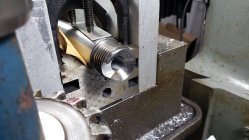Customer has a couple of 98 Mausers and a 1903A3 he's bringing in for rebarreling.
I'm told the 03 is a DP marked receiver. Assuming inspection shows just minor tack welds at the receiver ring any reason to suspect damage to the heat treat? Haven't worked on one of these yet so looking for input from those who have. If I see any evidence of more destructive welding I'll punt it back to him.
I believe he's bringing a take-off for the rebarreling. Assuming the "usual" work of setting back the shoulder, breech, and deepening the chamber- how is the extractor cut handled, is there a standard width key cutter that will make short work of this in the mill?
Also wants D&T for a mount- I've read the receiver can be as hard as peckerwood, is it necessary to spot anneal for this?
Anything else to know about the 03?
I'm told the 03 is a DP marked receiver. Assuming inspection shows just minor tack welds at the receiver ring any reason to suspect damage to the heat treat? Haven't worked on one of these yet so looking for input from those who have. If I see any evidence of more destructive welding I'll punt it back to him.
I believe he's bringing a take-off for the rebarreling. Assuming the "usual" work of setting back the shoulder, breech, and deepening the chamber- how is the extractor cut handled, is there a standard width key cutter that will make short work of this in the mill?
Also wants D&T for a mount- I've read the receiver can be as hard as peckerwood, is it necessary to spot anneal for this?
Anything else to know about the 03?











